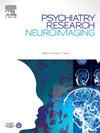Machine learning based classification of excessive smartphone users via neuronal cue reactivity
IF 2.1
4区 医学
Q3 CLINICAL NEUROLOGY
引用次数: 0
Abstract
Excessive Smartphone Use (ESU) poses a significant challenge in contemporary society, yet its recognition as a distinct disorder remains ambiguous. This study aims to address this gap by leveraging functional magnetic resonance imaging (fMRI) data and machine learning techniques to classify ESU and non-excessive smartphone users (n-ESU) based on their neural Cue-Reactivity (CR) signatures. By conducting a CR task and analyzing brain activation patterns, we identified spatial similarities between addictive smartphone use and established addictive disorders. Our approach involved employing Support Vector Machines (SVM) for classification, enhanced with feature selection methods such as Recursive Feature Elimination (RFE) and Model-based Selection and dimensionality reduction methods such as and Principal Component Analysis (PCA) to mitigate the challenges posed by limited dataset size and high dimensionality of fMRI data. The results demonstrate the effectiveness of our classification model, achieving accuracies of up to 79.9 %. Furthermore, we observed region-specific activations contributing significantly to classification accuracy, highlighting the potential biomarkers associated with ESU. External validation on longitudinal data revealed the necessity for larger training datasets to improve model generalizability. Additionally, feature selection techniques proved crucial for optimizing model performance, particularly in datasets with combined information from multiple sources. Our findings underscore the importance of incorporating more data to enhance model stability and generalizability, with implications for advancing the understanding and treatment of ESU and related disorders. Overall, our study demonstrates the promise of machine learning approaches in elucidating neural correlates of ESU and informing targeted interventions for affected individuals.
基于机器学习,通过神经元线索反应对过度使用智能手机的用户进行分类。
过度使用智能手机(ESU)是当代社会面临的一个重大挑战,但其作为一种独特疾病的认知仍然模糊不清。本研究旨在利用功能磁共振成像(fMRI)数据和机器学习技术,根据神经线索-反应(CR)特征对过度使用智能手机者(ESU)和非过度使用智能手机者(n-ESU)进行分类,从而填补这一空白。通过执行CR任务和分析大脑激活模式,我们确定了成瘾性智能手机使用与既有成瘾性疾病之间的空间相似性。我们的方法包括使用支持向量机(SVM)进行分类,并通过递归特征消除(RFE)和基于模型的选择等特征选择方法以及主成分分析(PCA)等降维方法进行增强,以缓解数据集规模有限和 fMRI 数据维度较高所带来的挑战。结果表明,我们的分类模型非常有效,准确率高达 79.9%。此外,我们还观察到特定区域的激活对分类准确性有显著贡献,突出了与 ESU 相关的潜在生物标志物。纵向数据的外部验证表明,需要更大的训练数据集来提高模型的通用性。此外,特征选择技术对于优化模型性能至关重要,尤其是在综合了多种来源信息的数据集上。我们的研究结果强调了纳入更多数据以提高模型稳定性和可推广性的重要性,这对促进对 ESU 和相关疾病的理解和治疗具有重要意义。总之,我们的研究表明,机器学习方法有望阐明 ESU 的神经相关性,并为受影响的个体提供有针对性的干预措施。
本文章由计算机程序翻译,如有差异,请以英文原文为准。
求助全文
约1分钟内获得全文
求助全文
来源期刊
CiteScore
3.80
自引率
0.00%
发文量
86
审稿时长
22.5 weeks
期刊介绍:
The Neuroimaging section of Psychiatry Research publishes manuscripts on positron emission tomography, magnetic resonance imaging, computerized electroencephalographic topography, regional cerebral blood flow, computed tomography, magnetoencephalography, autoradiography, post-mortem regional analyses, and other imaging techniques. Reports concerning results in psychiatric disorders, dementias, and the effects of behaviorial tasks and pharmacological treatments are featured. We also invite manuscripts on the methods of obtaining images and computer processing of the images themselves. Selected case reports are also published.

 求助内容:
求助内容: 应助结果提醒方式:
应助结果提醒方式:


